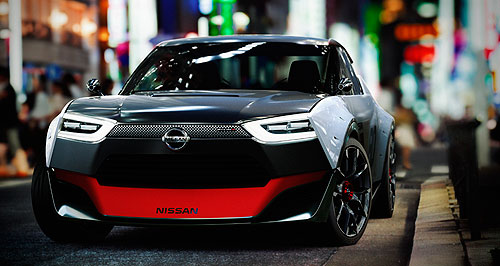Make / Model Search
Future models - Nissan - iDxNissan wants new ‘Silvia’ with a Gen Y-friendly twistCrowd-sourced: The Nissan IDx may look like a slice of history, but its maker will break with tradition in its execution. Reported slow Toyota 86 sales vindicate unusual approach with IDx, says Nissan chiefGallery Click to see larger images 11 Mar 2014 By MIKE COSTELLO in GENEVA NISSAN executive vice president Andy Palmer says reports of slow sales for the Toyota 86 in key markets vindicate the contrasting approach his company has taken in developing its own affordable rear-drive coupe for the road, as previewed by the IDx in Tokyo last November. Unlike the classically styled 86 and its Subaru BRZ twin, the IDx instead uses retro styling cues that hark back to old-school brand classics such as the Datsun 1600 and Datsun 510. The concept emphasises simplicity and affordability, even stretching to hypothetical repair costs. In addition, rather than emphasising outright performance, Nissan instead places more importance on the well-worn youth buzzword ‘personalisation’, pointing to the fact that it relied heavily on feedback from so-called ‘digital natives’ born after 1990 in the design of the car, and will also theoretically allow buyers to customise their car online once it enters production. This approach defines the car, said Mr Palmer, who told GoAuto last week that car-makers “have a responsibility to bring those people back in”, and said it was vital car-makers move away from the more traditional approach of Toyota and Subaru – and presumably others – if they wish to re-claim young buyers that are increasingly shying away from driving cars or getting licenses at all. Mr Palmer has previously said the IDx is favoured to enter production inside a few years. The racier of the pair of IDx concepts shown last November, dubbed the Nismo, is the one most likely to rub off on the road car, said Mr Palmer last week. Mr Palmer also did not rule out dusting off the beloved 200SX/Silvia badges, calling it “an asset” and saying Nissan’s planners “don’t discount the possibility of the... name being used”. “We set out with a strategy that said we wanted to create something that was not in the form of a classical sportscar,” he said. “From our point of view the classical sportscar has a place, but when you talk about Gen X and Gen Y, they’re looking at something different, and a re-definition of what the sportscar should be. “So from our point of view, the IDx on one side as an affordable, rear drive, small-engined fun to look at car, and on the other side BladeGlider (a radical EV convertible concept also premiered in Tokyo last November), is the approach one should be taking to that new generation. “If anything, I would go so far as to say that it (Toyota’s 86 global sales) vindicates the position we’ve been trying to take. “(It’s the) styling, the connectivity, the personalisation. You can configure the vehicle online. That sits well with the social media users who don't buy cars.. (that are) not even taking their driving test in many cases.” Reports of slow sales on the Toyota 86 stem from comments Toyota Europe research and development vice-president Gerald Killmann made to UK magazine Auto Express last month, stating that development of hotted-up and cabriolet derivatives was paused due to sales levels. The sluggish 86 sales are certainly not reflected in Australia, with the car far and away the top-selling sportscar Down Under thanks to its $29,990 starting price. In 2013, Toyota sold 6706 units despite mammoth waiting lists, and has chalked up a further 901 units this year. Last year’s sales figure was more than three-times the initial projected allocation for Australia. The fact that Toyota has received this greater supply is a sign that sales are lagging elsewhere, and the excess is heading to our shores.  Read moreAll motor show Alfa Romeo Alfa Romeo Abarth Abarth Alpine Alpine Alpina Alpina Audi Audi Aston Martin Aston Martin BMW BMW Bentley Bentley Chery Chery Brabham Brabham Chrysler Chrysler Chevrolet Chevrolet Cupra Cupra Citroen Citroen DS DS Dodge Dodge Fiat Fiat Ferrari Ferrari Foton Foton Ford Ford Great Wall Great Wall FPV FPV Haval Haval GWM GWM Honda Honda Holden Holden Hummer Hummer HSV HSV Infiniti Infiniti Hyundai Hyundai Jaguar Jaguar Isuzu Isuzu Kia Kia Jeep Jeep Land Rover Land Rover Lamborghini Lamborghini Lexus Lexus LDV LDV Mahindra Mahindra Lotus Lotus Mazda Mazda Maserati Maserati Mercedes-AMG Mercedes-AMG McLaren McLaren MG MG Mercedes-Benz Mercedes-Benz Mitsubishi Mitsubishi Mini Mini Opel Opel Nissan Nissan Peugeot Peugeot Pagani Pagani Proton Proton Porsche Porsche Renault Renault Ram Ram Rover Rover Rolls-Royce Rolls-Royce Skoda Skoda Saab Saab SsangYong SsangYong Smart Smart Suzuki Suzuki Subaru Subaru Toyota Toyota Tesla Tesla Volvo VolvoMotor industry news |
Click to shareAll motor show Alfa Romeo Alfa Romeo Abarth Abarth Alpine Alpine Alpina Alpina Audi Audi Aston Martin Aston Martin BMW BMW Bentley Bentley Chery Chery Brabham Brabham Chrysler Chrysler Chevrolet Chevrolet Cupra Cupra Citroen Citroen DS DS Dodge Dodge Fiat Fiat Ferrari Ferrari Foton Foton Ford Ford Great Wall Great Wall FPV FPV Haval Haval GWM GWM Honda Honda Holden Holden Hummer Hummer HSV HSV Infiniti Infiniti Hyundai Hyundai Jaguar Jaguar Isuzu Isuzu Kia Kia Jeep Jeep Land Rover Land Rover Lamborghini Lamborghini Lexus Lexus LDV LDV Mahindra Mahindra Lotus Lotus Mazda Mazda Maserati Maserati Mercedes-AMG Mercedes-AMG McLaren McLaren MG MG Mercedes-Benz Mercedes-Benz Mitsubishi Mitsubishi Mini Mini Opel Opel Nissan Nissan Peugeot Peugeot Pagani Pagani Proton Proton Porsche Porsche Renault Renault Ram Ram Rover Rover Rolls-Royce Rolls-Royce Skoda Skoda Saab Saab SsangYong SsangYong Smart Smart Suzuki Suzuki Subaru Subaru Toyota Toyota Tesla Tesla Volvo VolvoMotor industry news |





























Facebook Twitter Instagram